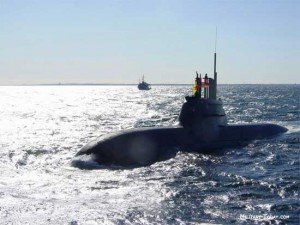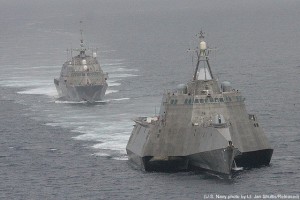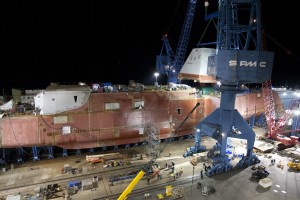If your Navy/Coast Guard is facing fiscal hard times, what areas of the budget should be targeted first? What should be targeted last? Why?
This is the first in our series of posts from our Maritime Futures Project. The project is designed to illustrate possible developments in naval affairs and maritime security in the near-, medium-, and long-term tomorrows. As such, our brave contributors are making predictions about the future challenges, opportunities, and technologies for maritime professionals – as well as things we’d like to see come to pass. They are also hazarding recommendations, based on those predictions, for the tough choices faced by many of our sea services.
Note: The opinions and views expressed in these posts are those of the authors alone and are presented in their personal capacity. They do not necessarily represent the views of their parent institution U.S. Department of Defense, the U.S. Navy, any other agency, or any other foreign government.

While we were fortunate to receive some responses from international contributors, most of the submissions came from contributors in the U.S. As such, the majority focus on the effects of the multiple complications and ‘threats’ to the U.S. Navy’s budget and how cuts could best be absorbed (much more seriously than I did here). Major acquisition programs such as the DDG-1000, F-35B, and LCS were singled-out for the first cuts, but so were things like the number of government civilians and ships’ steaming hours. On the flip-side, the F-35C and the large-deck amphibs to support them – to potentially lessen the pressures on carrier presence, were highlighted by some as items in the budget to protect, along with areas such training, readiness, and R&D. As expected from a group of people with maritime interests, there is a general belief that cutting can be dangerous if not done right. See also the results of our internal informal poll at the bottom, based on the suggestions of these contributors.
CDR Chris Rawley, USNR:
First: The U.S. Navy has too many programs currently on the books that are simply unaffordable and threaten overall shipbuilding numbers. The F-35C (the carrier-version of the Lightning II Joint Strike Fighter) is probably first among these. The F-35B (The short take-off/vertical launch version) is still a viable program because it allows LHA/LHD ships to become small aircraft carriers for strike. Especially for its cost, the DDG-1000 doesn’t bring significant war-fighting capabilities not present in other ship types. Some of the more superficial personnel programs should be examined with a critical eye for budget cuts, starting with the disastrous Task Force Uniform.
Last: Training pipelines, maintenance, and logistics infrastructure (including Combat Logistics Force (CLF) ships) should not be cut any further. The U.S. Navy has paid a price in readiness for the cuts these areas took last decade. The foundations of readiness cannot be reconstituted rapidly in a crisis.
LT Drew Hamblen, USN:
Efficiencies: Fiscal and man-hour efficiencies could be gained by following a naval aviation squadron model similar to the Air Force’s division of labor. They have been successful in managing their units without overloading pilots by reducing the number of pilots and instead using more admin and maintenance professionals that do not fly to focus on those tasks.
First: We could cut our overall manning and increase the proficiency/flight hours per pilot by focusing their efforts on their primary jobs instead of splitting their time with collateral duties that require significant training and frequent turnover. An admin/maintenance professional would not have to relearn his non-flying duties every 5 months. Pilots could spend more time improving their skills. An additional possible configuration would see some of the admin duties performed by personnel in a non-deployable status, with their workload shifted to augmented admin departments on surface ships’ to cover the squadrons’ needs – but that would require additional training and personnel for surface ships.
Last: Flight hour funding should not be cut unless the number of pilots is reduced. Reducing pilot numbers requires a reduction in collateral duties.
Felix Seidler, seidlers-sicherheitspolitik.net, Germany:
For my country of Germany, what we should not target for cuts are our submarine and counter-mine capabilities. Here, Germany has unique capabilities, should be preserved for joint missions with our allies. Moreover, there’s not much left that can be targeted. Thus, to achieve any savings while still preserving maritime capabilities, all future projects should proceed under cooperative agreements with allied countries to pool or share naval assets. The proposed Joint Support Ships for the German Navy could be purchased as a common project with countries like France, the Netherlands, Denmark, or Poland.
Sebastian Bruns, Fellow, Institute for Security, University of Kiel, Germany:
The German Navy has just over 15,000 people and is the smallest branch of the German military. With the end of conscription in 2011, it has been increasingly difficult to recruit qualified personnel. At the same time, the whole Bundeswehr is undergoing another, very ambitious reform.

The German Navy will give up all eight of their old work-horses, the F-122 frigates of the Bremen-class (built in the 1980s) which are to be replaced by the planned four frigates of the Baden-Württemberg-F125-class (to join the fleet between 2016 and 2018). Moreover, the fast-attack craft component of the Navy will be withdrawn from service. Diesel submarines of the 206A-class have already been decommissioned, cutting the German Navy’s number of submarines in half by the stroke of a pen (only a handful of new state-of-the-art submarines of the 212A-class remain). The four new corvettes of the Braunschweig-class have been plagued by design challenges and mechanical failures, but have seen their first operational deployments in late 2012. The future plan of the German Navy calls for up to two Joint Support Ships (JSS), but it remains to be seen if that can be arranged, what design will be chosen, and whether the funds for these vessels can be made available. It should also be interesting to watch whether – as this pundit hopes – such an ambitious project will go hand-in-hand with a very desirable political debate about the role and value of seapower for German foreign and security policy.
The most sought-after investments for the German Navy, in this analyst’s opinion, are (1) the replacement of the aging Sea King (SAR) heavy helicopters and the mid-term replacement of the P3-Orion maritime patrol aircraft. (2) A capable JSS must be on time, on budget, and meet the real operational needs (this would mandate an even larger investment in something akin to a naval or maritime security strategy). (3) German participation in a sea-based BMD is also very desirable. (4) More generally speaking, the attractiveness of the naval force as an employer must be enhanced to recruit personnel in sufficient strength and quality.
Dr. Robert Farley, Professor, University of Kentucky:
This is a very difficult question. I think that, given the missions they’ve been tasked with, both the USN and USCG are at the limits of their capabilities. If absolutely necessary, force cuts should be balanced in order to prevent creating holes in the force; the services should maintain a balance of surface, air, and subsurface capabilities. While I don’t relish the idea of cutting the nuclear deterrent, I think that the United States could probably manage with 6-8 SSBNs instead of the current 10.
Bryan McGrath, Director, Delex Consulting, Studies and Analysis:
If the U.S. Navy is facing fiscal hard times, it is only because senior U.S. decision makers do not have the courage to think strategically, preferring as they do to issue equal or nearly equal cuts to the Armed Services so as not to upset the “Joint” applecart, nor to unduly gore the oxen of particularly powerful constituencies on Capitol Hill. Were the courage to exist, the Navy would likely receive higher appropriations, in proportion to its strategic importance to the national security of the United States. Given the unlikelihood that such courage exists, I then move to answer the questions posed.
Assuming that the Navy must be cut, I would privilege readiness, capability, and R&D over capacity. This means, I would cut ship and airwing strength through early retirements, dramatically if need be, in order to retain, sustain, and obtain high-end warfighting capability. As for what should be targeted last, I believe any cuts to the procurement of precision-guided munitions should be avoided. Stocks of such weapons must be increased. Please remember—these suggestions are made given a requirement to decrease Navy Total Obligation Authority (TOA). I consider such a requirement to be strategically inane.
CDR Chuck Hill, USCG (Ret.):
The funding structure of the Coast Guard needs an overhaul. It has never been a good fit in any of the Departments it has been assigned to. A multi-purpose agency does not seem to integrate well in a government that seems able to deal with only one objective at a time. The Coast Guard is overseen by too many Congressional committees with divergent interest, most of whom see only small parts of the Coast Guard. Most significantly, as an armed force, it is part of the nation’s maritime security apparatus, but because it is not funded under DOD, relatively little attention is given to either its wartime role or funding for that role.
The Coast Guard has already fallen on hard times. Congress is attempting to cut spending at a time when, because of the cyclical nature of its shipbuilding, Coast Guard funding needs to be increased rather than cut. Many ships will be over 50 years old before they are replaced. Unfortunately it appears the Coast Guard needs to cut current operations to fund investment in future capabilities.
Bret Perry, Student, Georgetown University:

As a younger member of Generation Y, the idea of making serious cuts because of fiscal pressures is still quite foreign. Nevertheless, a procurement that requires further scrutiny is the U.S. Navy’s Littoral Combat Ship (LCS), specifically the Independence-class ships. It’s not that I disagree with purpose of the LCS class, but building both designs during fiscally challenging times is unreasonable. Although the Freedom and Independence classes each have their own pros and cons, I believe that the Freedom-class is more likely to reach the requirements originally envisioned for the LCS.
Despite being just as controversial as the LCS, the F-35B should be one of the programs last targeted for cuts because of its strategic importance. With the U.S. attempting to undertake its “pivot” to Asia and continuing to maintain two carriers in the Persian Gulf, America’s carrier capabilities will remain stressed. Although the USMC’s LHDs do not completely replace the power projected by an aircraft carrier, they do help relieve some of this stress by serving as a sea-based platform for a 5th generation aircraft, the F-35B.
Chris Putko, JIATF South:
Across the board, the question is no longer “if” the services/combatant commands/task forces are experiencing fiscal tightening, but how. We at JIATF South are getting our MPA (Maritime Patrol Aircraft) hours and ship deployments (USN FFGs, various USCG vessels) slashed. Since our JOA (Joint Operational Area) is so big – the CARIB (Caribbean) and EASTPAC (Eastern Pacific), intel plays a huge part in getting what few assets we have under our TACON (tactical control) where they need to be, and thankfully, our intel support has been great. Finding additional methods and technologies to enhance the targeting of illicit traffickers would be a great area to allocate additional monies, especially in an asset-constrained environment.
On the flip side, I think if cuts have to be introduced (and they do), I think it should be on personnel, specifically government civilians. Having served in multiple “good deal” duty stations, the revolving door of people getting out of the service only to take a pay increase and accept a position as a civilian in the same command is all too common. Everyone likes a good deal, but profligate hiring/promoting has become the norm, especially in duty stations in which there is a relatively higher local standards of living.
YN2(SW) Michael George, USN:
If the Navy were facing fiscal difficulties (which it may already be), I would first curtail the number of times ships are required to get underway. Certainly there are a number of reasons to police our waterways and there are a number of reasons to get underway, but when it costs so much each time for this undertaking, I believe that there could be much more activity consolidated into fewer underways.
The last thing I would cut back on is difficult, but one thing that comes to mind is medical care. Serving in any military branch is a potentially dangerous undertaking, and what Tricare offers is one of the major aspects of Service that keeps the Navy (and other branches) so appealing.
LT Jake Bebber, USN:
I’ll take a contrarian view on this for a moment. While I have no doubt that one can easily find waste in the Department of Defense or Department of the Navy (or any public or private organization with more than two people), is this the right question to ask? I think not. The better question is … what is our national security policy, what is our strategy to achieve those policy objectives, and how does the U.S. Navy fit into that strategy? From there, we ask: based on that strategy, what force structure will permit the Navy to fulfill its mission, and how much will that cost? The emphasis must be on matching funding to strategic objectives, not “cutting waste” for its own sake. Cutting top-line budget numbers achieves no strategic objective and does not put the Navy in position to fulfill its primary mission of fighting and winning the nation’s wars. My message to policy makers is this: you tell me what you want to accomplish, and I’ll tell you what force structure you need to do that mission. From there, we can discuss costs.
Alan Tweedie, Colorado:
The Navy seems to be in a perpetual budget crisis. If you ask the leadership they always seem to be running at a profound shortage. The best way to improve the fiscal situation for our Navy is to build ships with longer planned service lives rather than investing in new platforms. Take Oliver Hazard Perry FFG’s, the U.S. Navy is almost done with the class and is moving on with LCS, yet most of the OHP’s are still in service… in other navies. If we had elected to improve and modernize the class rather than sell them off we could be providing adequate combat capability with much less investment. This meme runs through the whole Defense Department, we just love shiny new toys.
LCDR Joe Baggett, USN:
Efficiencies: Streamline (reduce) future acquisition programs/projects.
We must always have an eye towards the future to constantly evolve and develop our force of tomorrow. However, we must also recognize our fiscally constrained times. It is increasingly difficult to sustain today’s force while also building for tomorrow. Since it is getting tougher to do both, our priority must be sustaining and advancing today’s proven capabilities while selectively developing programs that offer the greatest impact for the future at the earliest window.
Results of informal poll in CIMSEC’s Internal Discussion Facebook Group
What Should Be Cut First?
F-35C: 4 50%
Government Civilians: 3 38%
DDG-1000: 3 38%
Superficial personnel programs: 2 20%
Number of SSBNs: 2 20%
Independence-class LCS: 1 13%
Ship underway time: 0 0%
Early airwing and ship retiremnt: 0 0%
Total # of voters: 8
What Should Be Cut Last?
Training: 5 45%
Maintenance: 4 36%
Logistics infrastructure: 3 27%
F-35B: 1 9%
Readiness: 1 9%
R&D: 0 0%
Procurement of precision-guided munitions:0 0%
Targeting intel for counter-drug ops: 0 0%
Tricare (healthcare) funding: 0 0%
Total # of voters: 11

